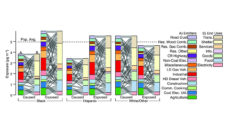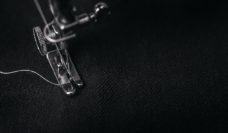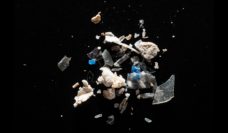Microplastics are tiny pieces of trash about the size of a sesame seed. Some microplastics come from larger non-biodegradable plastic waste like food containers, others are manufactured as additives to consumer goods. Microbeads, for example, were once added to cosmetic products like toothpaste and soap because they provide an exfoliating sensation. However, the Microbead-Free Waters Act of 2015 prohibits selling products containing microbeads because they do not dissolve, creating a threat to oceans and fresh water sources when they wash down drains.
Emerging evidence suggests that microplastics are increasingly present in the air, food, and water. Some research suggests that rain and global winds carry plastic particles, resulting in contaminated rain, snow, soil, and air. Microplastics tend to enter our drinking water from runoff, industrial waste and sewage spills, and dumping of deteriorating plastic fragments on land.
In a recent study, Kieran Cox and colleagues assessed the number of microplastic particles found in air and foods commonly eaten by Americans like seafood, sugars, salts, and honey. They also explored how beverages and different sources of drinking water are contaminated. The researchers found that air contained 9.80 microplastic particles per cubic meter on average. Water in disposable plastic bottles contained 94.37 microplastic particles per liter on average, but beers contained a third of that level. According to Cox, it is hard to definitively say, but the bottle type and the bottling process may play a role in this observed difference between bottled water and beer.
There’s something unsettling about knowing we are ingesting tiny pieces of plastic whenever we eat or drink, and have been for generations, most likely.
“The vast majority of bottled water samples come from plastic bottles, while beer samples come from glass or possibly cans,” said Cox. “However, data would be needed to clarify the issue.”
There’s something unsettling about knowing we are ingesting tiny pieces of plastic whenever we eat or drink, and have been for generations, most likely. Should these levels concern us? That’s what researchers are trying to figure out. Overall, the bad news is, no one really knows what these numbers mean in terms of human health yet.
“There are still many unknowns in terms of the impacts of microplastics within the human diet,” said Cox.
Consuming microplastics has been proven to be harmful to fish and other marine life because the tiny plastics block digestive tracks and reduce appetites, which inhibits their growth and reproductive ability. But the study of these tiny plastics on human health is still a developing field.
Cox and colleagues concluded that any current recommendations to avoid certain foods to reduce microplastic exposure would be unsubstantiated. The WHO recently declared that there is not enough evidence to determine that microplastics pose a risk to human health. It seems as if it is safe to continue drinking bottled water and eating seafood, for now.
Photo by Brian Yurasits on Unsplash














